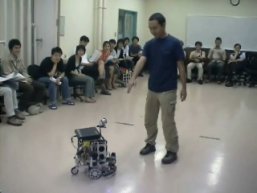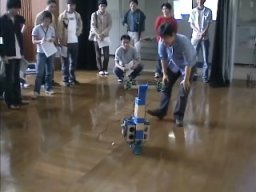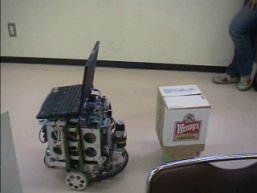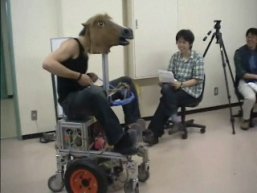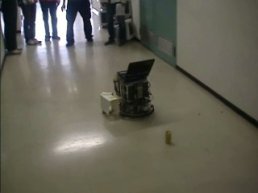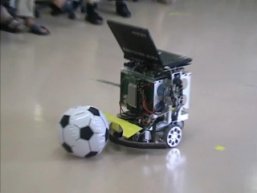Winning Entries of Demo Program Contest 2006
1st Place: RobotPet
This robot is equipped with a USB camera and laser range sensor. First, the robot finds a person coming up front, detect the distance using the laser range sensor, and photo from 3 angles are taken using the camera. Feature detection on the photos are done via SIFT and then the person is recognized as the robot's owner. The robot identifies the owner from other people, and follows the owner around only.
2nd Place: Inverted Pendulum with Ultrasonic
3rd Place: Shopping Robot
When people go to their destination, they depend on the landmarks in the environment and move about, for example "Turn right at this shop, and then go left". In this demonstration, this kind of topological map representation is used to achieve robot navigation. A representation of landmarks corresponding with the orientation and direction to move to is given to the robot, and the laser range sensor detects the landmark.
Horse
The horse is steered by pulling the reins. The trotting rhythm of fun is the selling point of this demonstration. Besides, by monitoring the torque required to initiate movement, the rider's presence can be detected. Being an intelligent horse, it refuses to run if there is no one riding on it.
Garbage Collecting Cyclone
The robot moves along the center of hallway which is detected using a laser range sensor. When it detects object which is thought as garbage, it moves towards it and collects the object by rotating and sweeping the object into the attached rubbish collection box (like a cyclone). It will not mistaken people as its target so it is safe to walk in the hallway!
Ball Rolling
Using a laser range sensor, this is a demonstration of a robot bringing back the ball to the person who kicked it. The robot detects the ball using laser range sensor, and goes towards the ball. After closing in the ball, the robot wraps around the ball and goes back to the initial position via odometry while holding the ball.
